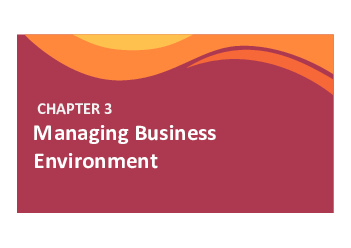



















Preview text:
lOMoARcPSD|36041561 CHAPTER 4 Foundations of Planning
Downloaded by Nga T??ng (ngahuong55@gmail.com) lOMoARcPSD|36041561 Content
ü The What And Why Of Planning ü Goals And Plans
ü Setting Goals and Developing Plans
ü Contemporary Issues in Planning
Downloaded by Nga T??ng (ngahuong55@gmail.com) lOMoARcPSD|36041561
4.1. Introduction to Planning v What Is Planning?
Ø A primary managerial activity that involves:
ü Defining the organization’s goals
ü Establishing an overall strategy for achieving those goals
ü Developing plans for organizational work activities v Formal planning
Ø Specific goals covering a specific time period
Ø Written and shared with organizational members
Downloaded by Nga T??ng (ngahuong55@gmail.com) lOMoARcPSD|36041561
4.1. Introduction to Planning v Why Do Managers Plan? ü Provides direction ü Reduces uncertainty
ü Minimizes waste and redundancy
ü Sets the standards for controlling
Downloaded by Nga T??ng (ngahuong55@gmail.com) lOMoARcPSD|36041561
4.1. Introduction to Planning
v Planning and Performance
ü Formal planning is positively associated with financial results.
ü The quality of planning and implementation affects
performance more than the extent of planning.
ü The external environment can reduce the impact of planning on performance. Failure reason
ü Formal planning must be used for several years
before planning begins to affect performance.
Downloaded by Nga T??ng (ngahuong55@gmail.com) lOMoARcPSD|36041561
4.2. How Do Managers Plan? v Goals/Objectives
ü Desired outcomes for individuals, groups, or entire organizations.
ü Direction and evaluation performance criteria. v Plans ü Resource allocation ü Activity schedules
Downloaded by Nga T??ng (ngahuong55@gmail.com) lOMoARcPSD|36041561 4.2.1. Types of Goals
v Financial Goals vs. Strategic Goals
Ø Volkswagen: Selling 10 million cars and trucks
annually with a pretax profit margin over 8%.
Ø Uniqlo: No.1 apparel retailer in the US.
v Stated Goals versus Real Goals Ø Broadly-worded official statements of the
organization that may be irrelevant to its real goals.
No.1 in the industry vs. Survival in the industry
Downloaded by Nga T??ng (ngahuong55@gmail.com) lOMoARcPSD|36041561 4.2.2. Types of Plans
Downloaded by Nga T??ng (ngahuong55@gmail.com) lOMoARcPSD|36041561
Downloaded by Nga T??ng (ngahuong55@gmail.com) lOMoARcPSD|36041561 4.2.3. Setting Goals
v Traditional Goal Setting
Downloaded by Nga T??ng (ngahuong55@gmail.com) lOMoARcPSD|36041561 4.2.3. Setting Goals
v Management By Objectives (MBO)
Ø Process of mutually agreed-upon goals and using
those goals to evaluate employee performance.
Ø Specific performance goals are jointly determined by employees and managers.
Ø Progress toward accomplishing goals is periodically reviewed.
Ø Rewards are allocated on the basis of progress towards the goals.
Downloaded by Nga T??ng (ngahuong55@gmail.com) lOMoARcPSD|36041561
Downloaded by Nga T??ng (ngahuong55@gmail.com) lOMoARcPSD|36041561 Does MBO Work?
Ø Potential Problems with MBO
ü Not as effective in dynamic environments that require constant resetting of goals.
ü Overemphasis on individual accomplishment may create problems with teamwork.
Downloaded by Nga T??ng (ngahuong55@gmail.com) lOMoARcPSD|36041561 v Well-Written Goals • Challenging yet attainable • Written in terms of outcomes, not actions Ø Low goals do not motivate.
Ø Focuses on the ends, not the
Ø High goals motivate if they can be means. achieved. • Written down
• Measurable & quantifiable
Ø Focuses, defines, and makes goals
Ø Specifically defines how the visible. outcome is to be measured and how much is expected.
• Communicated to all necessary • Clear as to time frame organizational members Ø How long before measuring
Ø Puts everybody “on the same accomplishment. page.”
Downloaded by Nga T??ng (ngahuong55@gmail.com) lOMoARcPSD|36041561
Downloaded by Nga T??ng (ngahuong55@gmail.com) lOMoARcPSD|36041561 4.2.3. Setting Goals Steps in Goal Setting
1. Review the organization’s mission statement.
Do goals reflect the mission?
2. Evaluate available resources.
Are resources sufficient to accomplish the mission?
3. Determine goals individually or with others.
Are goals specific, measurable, and timely?
4. Write down the goals and communicate them.
Is everybody on the same page?
5. Review results and whether goals are being met.
What changes are needed in mission, resources, or goals?
Downloaded by Nga T??ng (ngahuong55@gmail.com) lOMoARcPSD|36041561 4.2.4. Developing Plans
v Contingency Factors in Planning
Ø Manager’s level in the organization
ü Strategic plans at higher levels
ü Operational plans at lower levels
Ø Degree of environmental uncertainty
ü Stable environment: specific plans
ü Dynamic environment: specific but flexible plans
Ø Length of future commitments
ü Current plans affecting future commitments must be sufficiently
long-term to meet those commitments.
Downloaded by Nga T??ng (ngahuong55@gmail.com) lOMoARcPSD|36041561 4.2.4. Developing Plans
v Planning in the Hierarchy
Downloaded by Nga T??ng (ngahuong55@gmail.com) lOMoARcPSD|36041561 4.2.4. Developing Plans
v Criticisms of Planning
ü Planning may create rigidity.
ü Plans can’t be applicable in dynamic environments.
ü Restricts creativity.
ü Formal planning reinforces today’s success, which
may lead to tomorrow’s failure.
Downloaded by Nga T??ng (ngahuong55@gmail.com) lOMoARcPSD|36041561 4.2.4. Developing Plans
v Effective Planning in Dynamic Environments
ü Develop plans that are specific but flexible.
ü Change plans when conditions warrant.
ü Flatten the organizational hierarchy to foster the
development of planning skills at all organizational levels.
Downloaded by Nga T??ng (ngahuong55@gmail.com)


